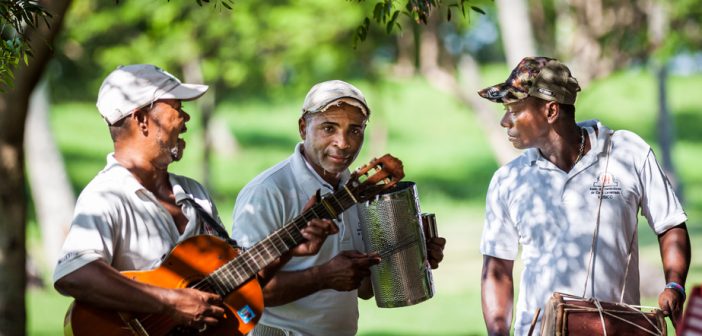Merengue and Bachata are the two primary ambassadors of Dominican Republic music nowadays, and it’s no wonder as thanks to the Spanish and African influences of these genres they have spread the Dominican droll and rhythm. The güira (metal scraper), tambora and the accordion make up the typical set of instruments, or the “perico ripiao” as it’s commonly known, and are central to the expression of this music that has spread around the world. Let’s learn a bit more about Dominican music.
Merengue
Its origins in the Dominican Republic date back to the 19th century, and it was initially played with guitars, and then later replaced by the accordion. This, together with the güira and the tambora represent the three cultures that make up the Dominican idiosyncrasy, the European influence with the accordion, the African with the tambora and the Taino with the güira. Merengue is the basis of most of the traditional Dominican songs and can very often be heard in the streets, bars, businesses and homes. Its heyday was during the 1970s with performers like Juan Luis Guerra, Tono Rosario, Fernando Villalona, Wilfrido Vargas, Johnny Ventura, Los Melódicos, Conjunto Quisqueya, Kinito Méndez, and many more.
Pambiche
Pambiche or “merengue apambichao” emerged in Puerto Plata and it is said to have originated in a sarcastic way during the North- American occupation between 1916 and 1924 when the locals saw how the Americans tried to dance to Dominican rhythms. This lead to the creation of a new dance step and a new tambora rhythm, whose lyrics spoke of a factory in Palm Beach, and the name Pambiche comes from the mispronunciation of these two words.
Atabales & Palos
Palo is an Afro-American music style that uses two or three long drums (palos or atabales), accompanied by güiras and singing. There is a “palero” (front man) in the group who sings the verses of the song while playing his palo and then the other paleros guide the audience to sing the chorus. This is the musical genre that shows the greatest influence of African rhythms and shares its origins with music from Cuba, Brazil and Haiti.
Tumba
Tumba was the national Dominican dance until the middle of the 19th century when couples bowed and changed partners in a complicated choreography which was similar to court dances of the 18th century.
Work songs
These were short and simple songs the people sang as they were working. They were used to coordinate timing with the work people were doing at the time. For example, when cutting trees, it was called “plena de hacha”, literally meaning full axe. They also used it when grinding rice, coffee and cocoa, and called it the “plena de majar”, meaning full grind, and also for digging the land before sowing seeds and called it “plena de hoyar”. There were also work songs with a more Hispanic influence and although they didn’t follow a particular rhythm, they were used to keep the people entertained as they worked.
Bachata
A hybrid of the Bolero, the Cha Cha Cha and the Son Cubano, Bachata means a night out on the town or partying and is a type of popular dance song that usually deals with the topics of love, melancholy and abandonment. It was often considered music for the lower-classes and known as bitter music; however, since the 1980s it has become more widely appreciated.
Other important musical genres include the Sarandunga, the Chenche Matriculado, the Carabiné, the Mangulna, the Zapateo and the Zuca.
Now that you know a little bit more about it, when you travel to the Dominican Republic, remember to keep an eye out for the music. If you go to Puerto Plata, the BlueBay Villas Doradas Adults Only**** Hotel is an excellent starting point to embark on this cultural journey. Let the rhythm guide you!






